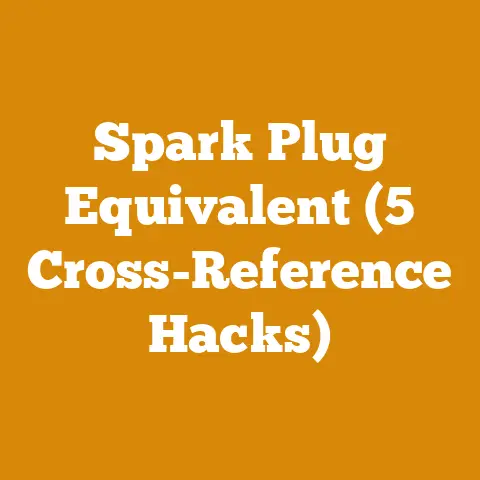Chainsaw Dies When Throttle (3 Fixes to Try)
Whether you’re in the thick forests of the Pacific Northwest or just handling some backyard maintenance in the Midwest, dealing with a chainsaw that dies when you throttle is a real pain.
I’ve had my fair share of battles with these beasts and am here to share what I’ve learned over the years.
Why Does This Happen?
Let’s take a moment to understand why your chainsaw might be acting up.
There are a few common culprits that can cause this issue:
- Fuel Issues: The wrong fuel mix or stale fuel can wreak havoc.
- Air Filter Problems: Clogged filters stop airflow, starving your engine.
- Carburetor Troubles: Misadjustments mean your engine isn’t getting the right fuel-air mix.
Understanding these basics helps us diagnose and fix the problem more efficiently.
Now, let’s delve into these fixes.
Fix 1: Check the Fuel
Fuel issues are often overlooked but critically important.
Let me tell you about a time when I was deep in the woods, miles from home, and my chainsaw sputtered out.
Turns out, my fuel was the problem.
Here’s how to avoid that:
Materials Needed:
- Fresh gasoline
- 2-stroke engine oil
- Clean container
Steps:
- Inspect the Fuel:
Examine your existing fuel.
If it’s been sitting for over a month, it could have absorbed water or degraded, impacting performance. - Mix New Fuel:
Always mix fresh gasoline with 2-stroke oil according to your chainsaw’s manual.
A common ratio is 50:1, but double-check yours. - Refill and Run:
Drain your old fuel, fill up with the new mix, and start the chainsaw.
Let it run at idle for a minute before throttling up.
Tips:
- Use a fuel stabilizer if you don’t operate your chainsaw regularly.
- Store fuel in a clean, dry place to prevent contamination.
Personal Story:
One winter, I learned the hard way how crucial this step is.
I was cutting wood for the fireplace when my chainsaw died repeatedly.
The culprit?
Stale fuel.
Since then, I’ve always ensured fresh fuel before every use.
Fix 2: Clean the Air Filter
A clogged air filter is like trying to breathe through a straw.
Here’s how to make sure your chainsaw gets all the air it needs.
Materials Needed:
- Screwdriver
- Mild soap
- Water
- Clean rag
Steps:
- Remove the Filter Cover:
Use a screwdriver to carefully take off the air filter cover.
Be gentle to avoid damaging any clips. - Inspect and Clean:
If it looks dirty, wash it gently with mild soap and water.
Rinse thoroughly and let it dry completely before reinstalling. - Reinstall and Test:
Place the filter back carefully and secure the cover.
Start your chainsaw and try throttling again.
Warning:
Running your chainsaw without an air filter can cause serious engine damage by allowing debris inside.
Experience Insight:
During my early days as a lumberjack, a clogged filter once cost me hours of downtime.
Since then, regular checks have saved me countless headaches.
Fix 3: Adjust the Carburetor
Carburetor issues are pretty common and a bit technical.
Don’t worry; I’ll guide you through it.
Prerequisites:
- Basic understanding of carburetor settings (H, L, and I screws)
Materials Needed:
- Small screwdriver
Steps:
- Locate the Screws:
Find the high (H), low (L), and idle (I) screws on your chainsaw.
They control fuel flow at different throttle levels. - Adjust Low-Speed Screw (L):
Turn clockwise to enrich or counterclockwise to lean out the mixture until you achieve smooth idling. - Adjust High-Speed Screw (H):
Adjust this screw until the engine runs smoothly at full throttle without cutting out. - Set Idle Speed (I):
This screw controls how fast the engine runs without engaging the chain.
Adjust until it idles smoothly without chain movement.
Caution:
Incorrect adjustments can severely harm your engine, so proceed with caution or consult a professional if unsure.
Pro Tip:
Mark the original screw positions before making changes so you can revert if needed.
Learning Moment:
Once, I adjusted the carburetor on a friend’s saw without knowing its history.
It was perfectly tuned for high altitude—something I didn’t consider at sea level!
Always check your settings relative to your environment.
In-Depth Troubleshooting Tips
Sometimes these fixes don’t entirely solve the problem, so let’s look at some additional troubleshooting tips:
Spark Plug Inspection
A faulty spark plug can cause misfires or prevent starting altogether.
- Remove and inspect for damage or build-up.
- Clean or replace if necessary.
Exhaust Blockage
A blocked exhaust can choke your engine.
- Check for carbon build-up.
- Clean or replace parts as needed.
Fuel Line Inspection
Cracked or blocked fuel lines can disrupt fuel flow.
- Inspect lines for visible damage.
- Replace if necessary to ensure proper flow.
Chain Tension Check
An overly tight chain can cause stalling under load.
- Ensure proper tension as per your manual.
- Adjust if necessary for smooth operation.
Common Questions
Q1: My chainsaw still dies under load after these fixes.
What next?
If you’ve tried these solutions and still face issues, it could be worth checking for compression problems or other mechanical faults that need professional attention.
Q2: How often should I replace my spark plug?
Generally, spark plugs should be replaced annually or every 100 hours of use to maintain optimal performance.
Q3: Can weather affect my chainsaw’s performance?
Yes!
Temperature and humidity can impact fuel efficiency and carburetor settings.
Adjust according to local conditions.
Safety First!
Remember, working with a chainsaw is inherently risky.
Always wear protective gear including gloves, goggles, and ear protection.
Ensure you’re working in a safe environment free from obstacles that could cause accidents.
Important Reminders
Routine maintenance is key to preventing issues like this from arising in the first place.
Regularly check your chainsaw’s components and keep them clean and properly adjusted.
Always prioritize safety over speed when handling such powerful equipment.
Whether you’re cutting firewood for winter or clearing fallen trees after a storm, having a reliable chainsaw is crucial for getting the job done efficiently and safely.
Keep these tips in mind, and don’t hesitate to seek professional help if things get too complicated.
Happy cutting!






